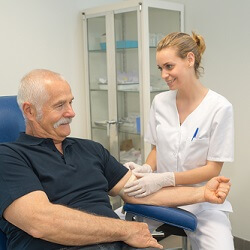What is a Phlebotomist?
Phlebotomists are responsible for taking patients’ blood samples.
This can be done by placing a needle in the arm of the patient and using a syringe to pull the blood out.
A Phlebotomist may also attach an IV to a patient to take blood or to insert medication.
Often, you can find Phlebotomists working in labs and in hospitals or doctor’s offices.
This career takes a bit of training and hand-eye coordination but can be a great profession or a step toward a promising medical career.
Duties
As a Phlebotomist, it will be your responsibility to take blood samples from patients and send them to the lab to check for issues.
This career requires a steady hand and not having a fear of needles.
You can find a Phlebotomist doing these activities on a daily basis:
- Identifying patients
- Labeling vials
- Deciphering the best methods of blood drawing
- Collecting blood samples
- Transporting blood samples
- Cleaning and sanitizing equipment
Salary
Working as a Phlebotomist can be considered an entry-level career in the medical field.
Since this career only requires one year of education, and sometimes less, the salary can reflect that.
Most Phlebotomists in the United States will make about $37,380 annually.
After several years of hands-on experience working as a Phlebotomist, and earning certifications, it’s possible to make up to $48,490 a year in this career.
However, this isn’t the salary you should expect when just beginning your journey in this field.
Those who are just beginning their career will make close to $28,990 or less, depending on the type of facility you work in and the population of the surrounding area.
Annually National Average Salary: $43,130
Average Annual Salary by State
| State | Avg. Annual Salary |
|---|---|
| Alabama | $35,940 |
| Alaska | $48,440 |
| Arizona | $44,160 |
| Arkansas | $36,690 |
| California | $52,370 |
| Colorado | $46,780 |
| Connecticut | $46,800 |
| Delaware | $48,630 |
| District of Columbia | - NA - |
| Florida | $39,680 |
| Georgia | $41,860 |
| Hawaii | - NA - |
| Idaho | $42,360 |
| Illinois | $43,450 |
| Indiana | $38,410 |
| Iowa | $39,750 |
| Kansas | $39,570 |
| Kentucky | $39,020 |
| Louisiana | $35,130 |
| Maine | $40,670 |
| Maryland | $48,970 |
| Massachusetts | $48,540 |
| Michigan | $41,510 |
| Minnesota | $44,100 |
| Mississippi | $33,330 |
| Missouri | $39,510 |
| Montana | $40,870 |
| Nebraska | $38,700 |
| Nevada | $43,660 |
| New Hampshire | $45,110 |
| New Jersey | $46,570 |
| New Mexico | $40,310 |
| New York | $50,110 |
| North Carolina | $40,670 |
| North Dakota | $44,020 |
| Ohio | $39,010 |
| Oklahoma | $37,440 |
| Oregon | $47,720 |
| Pennsylvania | $43,100 |
| Rhode Island | $47,690 |
| South Carolina | $39,090 |
| South Dakota | $37,520 |
| Tennessee | $37,030 |
| Texas | $41,170 |
| Utah | $38,080 |
| Vermont | $42,380 |
| Virginia | $43,580 |
| Washington | $50,800 |
| West Virginia | $37,000 |
| Wisconsin | $43,560 |
| Wyoming | $39,910 |
| Puerto Rico | $25,180 |
Annual Average Salary: Top 5 States
The top earning state in the field is California, where the average salary is $52,370.
These are the top 5 earning states in the field:
* Employment conditions in your area may vary.
How to Become a Phlebotomist
Step 1 Enter a Training Program
There are certain pieces of knowledge that you must acquire in order to be a successful Phlebotomist.
In order to learn everything that you need to know, you will have to join a program.
Training programs for Phlebotomists can be found at community colleges, universities, and training centers across the country.
It’s possible to earn a certificate online or in person, but you must always practice hands-on experience when working as a Phlebotomist.
This means that you will need to take an internship and do lab work in person.
Training programs can last anywhere from a few weeks to over a year or more.
Some of the things that you will learn in a Phlebotomist training program include:
- Blood Collection and Storage
- Laboratory Safety
- Biology
- Chemistry
You will also gain experience with hands-on training, taking blood, and inserting needles into fake skin as well as real skin at some point.
The length of the program can matter in different ways, short programs may not provide all of the necessary instruction.
Longer programs typically also provide students with the chance to work an internship as well as earn an Associate’s degree, for two-year programs.
Step 2 Become Licensed
Once you earn a certificate or degree as a Phlebotomist, you will need to become licensed in order to gain employment in some states.
Look up what is required from your state to be sure, but so far, the only states that require licensing are:
- California
- Nevada
- Louisiana
- Washington
Even though a license isn’t required in the other states, it doesn’t mean that it is useless.
Having a license will show employers and patients that you are competent in your job and that you are a responsible Phlebotomist.
Being licensed as a Phlebotomist can also help with promotions, career moves, and other opportunities.
Prospective license holders must pass an exam in order to gain licensure, the exam can vary from state to state.
Step 3 Gain Experience
Finding a career as a Phlebotomist can be easy if you are looking in the right places.
Most Phlebotomists work at hospitals, doctor’s offices, and labs.
There are also some others who work at blood drives and donation centers.
It’s possible that while you were going to school that your program required an internship.
Sometimes, employers will hire Phlebotomists right out of school after they’ve interned at the company.
This is a great way to build rapport with clients and employers, so if you are offered an internship, don’t hesitate to take it.
Some other ways to gain experience as a Phlebotomist include:
- Attending seminars
- Volunteering at Red Cross
- Volunteering at drug treatment centers
- Shadowing a medical professional
Step 4 Obtain Certification
Even if your state doesn’t require licensure, you could still earn certifications in other areas to show you are competent as a Phlebotomist.
Having certifications provides proof that you are knowledgeable and help you get ahead in your career.
Most certifications require that Phlebotomists have at least two years of experience in the field before taking the exam.
Make sure that any agency you go through to obtain certification is accredited.
This can be found through your local community college, hospital, or training school.
Some of the accredited agencies include:
- National Accrediting Agency for Clinical Laboratory Sciences
- American Society of Clinical Pathologists
- American Association of Medical Personnel
- American Certification Agency for Healthcare Professionals
Each association has its own list of certifications available for Phlebotomists.
A few of the certifications available are:
- Certified Phlebotomy Technician
- National Certified Phlebotomy Technician
- Medical Laboratory Scientist
All certifications require that you pass an exam.
Recertification is required every 3-5 years.
Popular Programs
Education
Since phlebotomy requires a skillful hand and knowledge of the medical field, it is important that a Phlebotomist get the education that they need.
Most phlebotomy programs in the United States can range anywhere from 8 weeks to 2 years and offer different levels of education.
It’s important to make sure that the program you enter is accredited by the National Accrediting Agency for Clinical Laboratory Science.
There are training schools that provide phlebotomy programs online, and it’s also possible to earn a certificate or a degree through a community college or university in person.
To be eligible to enter most phlebotomy programs, you must have the following:
- High school diploma or GED
- Be at least 18 years old
- A GPA of 2.5 or higher
You will learn many different things in a phlebotomy program, including classes on subjects like:
- Anatomy and Physiology
- Biology
- Laboratory Departments and Organization
- Specimen Collection
- Equipment and Techniques
While working toward a certificate, students will likely need to partake in an internship or clinical studies.
This can be done through many different facilities, including:
- Hospital labs
- Patient care centers
- Doctors offices
- Nursing homes
Tuition for an online program can be as little as $25 in some areas, and as much as $2,500 for other programs.
If you are looking for more education and want to earn an Associate’s degree, this will take around two years.
There are many types of degree programs for Phlebotomists, including medical assistants and medical technicians.
These programs will go more in-depth than a one-year or less program, and you will take courses that include:
- Microbiology
- Hematology
- Blood Banking
- Chemistry
- Urinalysis
- Laboratory Math
This type of degree will also require an internship and/or clinical studies.
Clinicals can provide students with hands-on experience so that they don’t go into the workforce completely confused.
Having an Associate’s degree as a Phlebotomist can set you apart by showing employers that you have the knowledge it takes to do a good job.
Video About The Career
Certification and Licensing
After enrolling in a program and passing you will earn either a certificate or a degree, depending on the type of program you choose.
Gaining a couple of years of experience as a Phlebotomist will help you in your question to gain certification.
Earning a certification as a Phlebotomist can open many new doors, but you must make sure that the association you are going to get certified with is accredited.
Some of the accredited associations include:
- American Society of Clinical Pathologists
- American Medical Technologists
- National Health Career Association
- American Society of Phlebotomy Technicians
Although certification is voluntary in most states, many employers like to see one on your resume.
For that states that do require certification, please follow state laws when finding the association to connect with.
The states the require certification are:
- California
- Louisiana
This is because it shows the employer and the patients that you have knowledge as a Phlebotomist, and can do the job that needs to be done.
There are several certifications that can be gained through various associations.
Some of the most popular certifications are:
- Phlebotomy Technician from the American Society of Clinical Pathologists
- Certified Phlebotomy Technician from the National Health Career Association
- Certified Phlebotomist from the American Society of Phlebotomy Technicians
All of the certifications require that you have at least a year of experience as a Phlebotomist in the last five years before you are eligible to apply.
Most certifications require that you pass an exam, which can cost anywhere from $60 to $250, depending on the certification and the association.
Earning a certification as a Phlebotomist can provide extra job support, as well as introduce new promotions and raises.
These certifications are good for two years and must be renewed in order to stay up to code in the medical field.
It may be hard to find a career without certification as a Phlebotomist.
Certification Example:
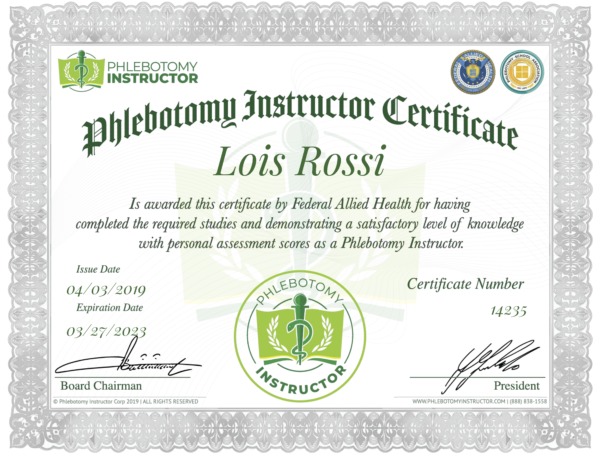
Average Training Program Duration: 1-2 Years
It doesn’t take too long to become a Phlebotomist, as little as 8 weeks in some areas.
However, you don’t want to enter a program that isn’t long enough, as you won’t learn the required knowledge and have a harder time finding a job.
Most phlebotomy programs take around 8 months to a year to complete, and that includes clinical lab work and possibly an internship.
Programs that take 8 months or less may not provide an internship in some areas.
Another important thing to consider when looking for programs is if they are accredited, some shorter programs do not have accreditation.
Job Outlook
Every year, it seems that there are more and more medical facilities popping up all over the country.
Thanks to all of the new hospitals, doctor’s offices, and laboratories, Phlebotomists should not have a problem finding a job in the next decade.
In fact, this career will grow around 22 percent over the next ten years.
Compared to other careers in the medical field, the growth rate for Phlebotomists is much faster.
Taking a patient’s blood is still an extremely reliable and essential part of the medical field, so this career will likely be around for a long time.
Phlebotomists are often found working at blood drives and blood banks, which can create more job opportunities as well, especially during a public health emergency situation.
Employment Growth Projection: 22%
2020
2030
That's a higher than average projected growth of 28,800
Should You Become a Phlebotomist?
Overall Satisfaction: Medium

Having a career as a Phlebotomist can be a bit stressful, especially when working in a big hospital or lab.
The stress can come from how many patients need to be seen at once, and the orders from doctors.
There isn’t much upward mobility without education in this career, either.
This can cause a bit of trouble for Phlebotomists who want to maintain a great career.
Depending on the location of the job, the hours can be stressful.
Those who work in labs or doctor’s offices will likely have hours from 9-5, while those who work in hospitals may have different shifts.
Working as a Phlebotomist is a good entry-level career in the medical field, but will not provide much upward mobility.
Average Salary: Low

Most Phlebotomists in the United States will make around $37,380 a year on average.
Those who are just starting out as a Phlebotomist will likely make closer to $28,990 in most areas.
Having a solid education, earning certifications, and having many years of experience can provide a salary close to $48,490 a year.
There are many things that can determine the salary of a Phlebotomist, including the location in which they work.
Phlebotomists working in large populations like California or Washington D.C. will make closer to $50,000 a year.
While Phlebotomists who are working in states like Iowa will make closer to $30,000 a year on average.
Job Growth Outlook: High

If you are looking to begin a career as a Phlebotomist, now would be the time to start your journey.
This career will grow around 22 percent over the next ten years, which is much higher than many other jobs in the medical field.
Phlebotomists are essential in hospitals and labs because taking blood is still one of the most accurate ways of diagnosing and treating patients.
Having certifications or further education will provide many more career growth opportunities in this career.
Education Duration: 1-2 Years

There are a few different options for the length of programs when becoming a Phlebotomist.
Some people choose to enroll in an 8-week program, which can teach the basics of Phlebotomy.
Other programs offer more extensive education and can take up to a year to finish.
Programs should teach you how to draw blood and provide hands-on experience working in labs.
It doesn’t take long to become a Phlebotomist, anywhere between 8 weeks and 1 year, with the average length being about 8 months, depending on the program.
Personal Skills Needed

In order to have a successful career as a Phlebotomist, you must not have a fear of needles or blood, and you should have a steady hand.
Other personal skills that will help you to do well in this career include:
- Compassion
- Detail-oriented
- Ability to multitask
- Team player
- Excellent communication skills
- Understanding of insurance and payment processing
- Understanding of medical terminology
- Empathy
- Customer service skills
- Ability to work well under pressure
- Physical stamina
Being kind-hearted in this career can be helpful because some patients may be scared, injured, or upset when getting blood drawn.
Frequently Asked Questions
What is the average salary for a Phlebotomist?
On average in the United States, a Phlebotomist makes $37,380 a year.
This is the typical salary for a career that doesn’t require a degree.
However, it’s possible to earn more money with education, certifications, and the required hands-on experience.
For Phlebotomists who have been working in the field for a while, the salary can be up to $48,490 in some areas.
There are some Phlebotomists who make closer to $30,000 a year, like in Iowa or Kansas.
How long does it take to become a Phlebotomist?
It can take as little as 8 weeks to become a Phlebotomist.
However, the average program takes about 12 months to finish.
The longer programs will provide more clinical lab work and hands-on education than a shorter program.
It’s even possible to earn an Associate’s degree to work as a Phlebotomist, which can take about two years to finish.
Most longer programs will also give students the chance to work an internship, supplying even more education and work experience.
What does a Phlebotomist do?
The role of a Phlebotomist is simple, even if the word may be hard to say.
These skilled individuals will take blood samples from patients and send them to a lab to be accessed.
They will also clean and sanitize work areas, help keep patients relaxed and at ease, and report any findings to doctors or medical staff.
Some Phlebotomists may work in blood banks or labs as well, which can provide a whole new list of duties like taking blood donations and analyzing data.
What is the demand for Phlebotomists?
Having a Phlebotomist in a doctor’s office or hospital will always be a requirement.
This is because a Phlebotomist is trained in taking blood for diagnosing diseases that could harm people.
The career will rise as much as 22 percent over the next decade, which is a lot more than many other careers in the medical field.
There are many reasons for the demand in Phlebotomists over the next decade, which includes advancements in technology that have made it easier to diagnose illnesses.
How much does it cost to become a Phlebotomist?
Since there are so many types of programs to become a Phlebotomist, there is a wide range of prices.
Some programs can cost as little as $250 to complete.
There are other programs that can cost up to $3,000, depending on the length of the program.
Other expenses could include certifications, licensing, and other fees for schooling.
This means that it can cost anywhere from around $500 to over $4,000 to become a Phlebotomist.
 Phlebotomist Info by State
Phlebotomist Info by State

- Alabama
- Alaska
- Arizona
- Arkansas
- California
- Colorado
- Connecticut
- Delaware
- Florida
- Georgia
- Hawaii
- Idaho
- Illinois
- Indiana
- Iowa
- Kansas
- Kentucky
- Louisiana
- Maine
- Maryland
- Massachusetts
- Michigan
- Minnesota
- Mississippi
- Missouri
- Montana
- Nebraska
- Nevada
- New Hampshire
- New Jersey
- New Mexico
- New York
- North Carolina
- North Dakota
- Ohio
- Oklahoma
- Oregon
- Pennsylvania
- Rhode Island
- South Carolina
- South Dakota
- Tennessee
- Texas
- Utah
- Vermont
- Virginia
- Washington
- West Virginia
- Wisconsin
- Wyoming
Phlebotomist Resources
- 14 Pros and Cons of Being a Phlebotomist
- American Red Cross Phlebotomy Training & Information
- Entry Level Phlebotomist Resume Tips & Advice
- History Of Phlebotomy
- How Much Does Phlebotomy Technician School Cost?
- How to Boost Your Phlebotomy Salary
- How to Deal with Rude Patients in Phlebotomy
- How To Draw Blood
- How to Get a Phlebotomy Job (Without Experience)
- Is Phlebotomy a Good Career Choice?
- Is There a Shortage of Phlebotomists in America?
- Online Phlebotomist Training Programs
- Phlebotomy Job Outlook
- Phlebotomy on the Job Training: What Should You Expect?
- Phlebotomy Order of Draw
- Typical Phlebotomist Job Duties & Job Description
- What is a Phlebotomy Technician?
- What to Expect with Phlebotomy And EKG Training
- Where Can a Phlebotomist Work?
- Where to Look for Entry Level Phlebotomy Jobs
More Medical Careers
| Career | |
|---|---|
 | Certified Nursing Assistant Working as a Certified Nursing Assistant is an entry-level role that will give you hands-on experience when you are ready to take the next step in your medical career. |
 | Dental Assistant Dental assistants help dentists to provide patient care, keep records, and care for the dental equipment. |
 | Dental Hygienist Dental hygienists take care of cleaning teeth to promote hygiene and help avoid cavities and gum problems. |
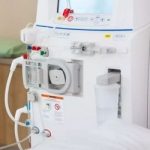 | Dialysis Technician Dialysis technicians maintain and monitor dialysis equipment, and also act as primary caregivers for patients undergoing dialysis treatment. |
 | Dog Groomer Dog groomers attend to grooming dogs, usually at dog salons or big pet-related chain stores. |
 | Healthcare Administrator Healthcare administrators – also known as healthcare executives or health services managers – are responsible for the planning, direction, and coordination of medical and health services. |
 | Home Health Aide Home health aides provide home care to individuals who require assistance in their day-to-day living. |
 | Licensed Practical Nurse (LPN) Licensed Practical Nurses provide basic nursing care to patients and work with Registered Nurses and Doctors. |
 | Medical Assistant Medical assistants support the work of physicians, nurses, and other health professionals. |
 | Medical Biller and Coder Medical billers and coders manage, organize, and code various health information data. |
 | Medical Technologist Medical laboratory technologists collect bodily samples and conduct tests to analyze those samples. |
 | Medical Transcriptionist Medical transcriptionists go over voice recordings to convert them into written texts. |
 | Nutritionist As a Nutritionist, you’ll be tasked with creating meal plans, counseling, and understanding dietary restrictions for all types of clients. |
 | Patient Access Representative The work involves helping people to orient themselves to the space and everything that is going on. |
 | Patient Care Technician Patient care techs work directly with patients helping them with daily activities and assist the medical staff by measuring and monitoring the patients' vital signs among other tasks. |
 | Pharmacy Technician Pharmacy technicians provide patients with medications through prescription or over the counter. |
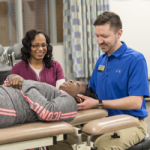 | Physical Therapist Assistant Physical therapist assistants provide physical therapy services to patients and aide to physical therapists. |
 | Professional Recovery Coach A professional recovery coach is a life coach who works with someone during their addiction recovery process. |
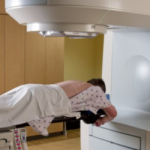 | Radiation Therapist Allied health provisional who specializes in radiation oncology treatments. |
 | Registered Health Information Technician Registered Health Information Technician (RHIT) help store and verify accuracy of health records as well as analyze patient data. |
 | Registered Nurse (RN) Registered Nurses provide hands-on patient care in various settings, mainly hospitals, and clinics. |
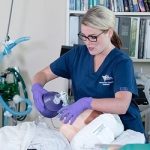 | Respiratory Therapist Respiratory therapists treat and care for patients who experience breathing difficulties. |
 | Sterile Processing Technician A sterile processing technician is a healthcare professional who is responsible for preparing, sterilizing, maintaining, packaging, and storing medical tools and equipment used in surgical and other medical procedures. |
 | Surgical Technologist Surgical technologists – also known as operating room techs – prepare operating rooms and assist doctors and nurses during surgical procedures. |
 | Vet Office Manager Veterinary office managers work to make sure that the daily operations run smoothly and efficiently at veterinary hospitals or veterinary clinics. |
 | Veterinary Assistant Veterinary Assistants work closely with Veterinarians to handle routine animal care. |
 | Veterinary Technician Veterinary Technicians assist veterinarians as well as diagnosing and treating animals, mostly in private clinics. |
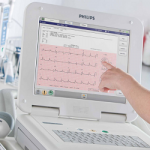 | EKG Technician EKG technicians test and monitor the cardiovascular system. |
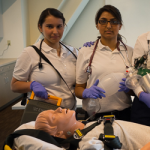 | EMT Trained emergency medical technician that arrives at the scene to provide medical services such as resuscitation. |
 | MRI Technologist MRI Technologists use a machine to scan the body and create a detailed image of the inside for doctors to analyze. |
 | Optician Opticians are technicians and salespersons at the same time who spends most of their day talking to customers, reading prescriptions written by doctors, and dispensing glasses and lenses. |
 | Ultrasound Technician Ultrasound technicians aid physicians in monitoring and diagnosing patients through the use of ultrasonic imaging technology. |
 | X-Ray Technician X-Ray Technicians are medical imaging professionals who use technology to visualize the inside of our bodies. |
